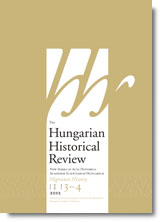Approaches to Interwar Hungarian Migrations, 1919–1945
Approaches to Interwar Hungarian Migrations, 1919–1945
Author(s): Tibor FrankSubject(s): History
Published by: Magyar Tudományos Akadémia Bölcsészettudományi Kutatóközpont Történettudományi Intézet
Summary/Abstract: The social upheavals that followed the First World War drove astonishing numbers of people in all directions. Russian and Ukrainian refugees escaped Bolshevism in Belgrade; Poles were relocated into reemerging Poland; Hungarians escaped from Romania and the newly established states of Czechoslovakia and Yugoslavia. Many people went on substantial and extended study tours to Germany, much as others had done before the war. Migrations were not limited to Jews suffering from the political and educational consequences of the White Terror in Hungary. Yet Jewish migrations were a definitive pattern of the 1920s, when the “Numerus Clausus” act of XXV: 1920 excluded many of them from college. A significant, though smaller, group of non-Jews also left Hungary at the same time. Motivated by anti-liberal politics, poverty, or curiosity, gentiles of mixed convictions and confessions hit the road and tried their luck in Paris, Berlin, or Hollywood.
Journal: The Hungarian historical review : new series of Acta Historica Academiae Scientiarum Hungaricae
- Issue Year: 1/2012
- Issue No: 3-4
- Page Range: 337-352
- Page Count: 16
- Language: English

